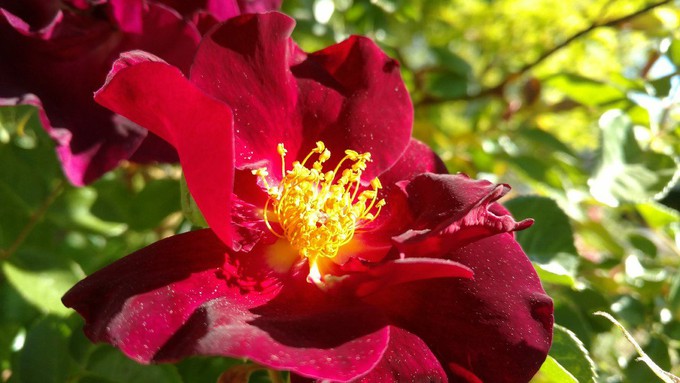
Put your roses on a regular diet with monthly feeding (plus snacks)

This Night Owl climbing rose appreciates its blanket of compost and mulch. Debbie Arrington
With rapid spring growth, my whole rose garden seems to be screaming: Feed me!
With moist soil and relatively mild weather conditions in the forecast, now is a good time to fertilize roses as they sprout new canes, lush foliage and their first wave of flowers.
But what to feed them? How do you fertilize roses in spring to support growth as well as prompt flowers?
Combine nourishment with weed control. For starters, use a combination of compost or other organic amendments and mulch.
“Apply organic soil amendments – such as (aged) horse manure, alfalfa meal, etc. – around the drip line of each of the roses,” instructs master rosarian Baldo Villegas, who grows more than 2,000 bushes in his Orangevale garden. “Some rosarians apply two inches of mushroom compost and another two inches of mulch for a total of four inches throughout whole garden bed to feed the soil, prevent weeds and preserve water moisture in the soil.”
Alfalfa meal (available at nurseries) or alfalfa pellets (available from feed stores) give roses an early burst of nitrogen – a must for new foliage. When buying alfalfa pellets, make sure it’s plain alfalfa and not amended with other ingredients such as molasses; rabbits may appreciate those extras, but they’ll just attract ants in the rose bed.
The mulch acts as a protective blanket around the bush. It speeds the decomposition of the alfalfa or manure underneath as well as smothers weeds – a big help for gardeners as well as roses. Mulch also conserves water, warms the soils, keeps roots comfortable, discourages fungal disease outbreaks and promotes healthy soil.
What mulch do roses prefer? Ground bark or dried leaves work best. Avoid rocks or gravel; they add nothing to the soil in the way of nutrients and, because they absorb heat, they can cook roots in summer. Rocks also tend to reflect heat onto the bush, further stressing the plant.
After that initial compost-mulch blanket, put your roses on a regular diet. Once a month, apply a slow-release rose food. Look for products with more phosphorus (the middle number of the three macronutrients listed on fertilizer bags) than nitrogen (the first number); phosphorus supports flowers while nitrogen prompts more leaves. Scatter fertilizer around bushes and water it in. Or use a liquid fertilizer and apply while watering. Never fertilize roses in dry soil; it can burn the foliage.
Roses can benefit from bone meal (an excellent source of phosphorus). After deadheading (removing spent blooms), scatter a few tablespoons of bone meal around the bush and work into soil. (You may need to pull the mulch away from the bush first.)
Other “snacks” to feed your roses: Fish emulsion and worm castings. Master rosarian Charlotte Owendyk of Roseville uses both. Applied while watering, nutrient-packed fish emulsion can give a weak or sluggish grower a little extra boost. Worm castings – and even better, active earthworms – help overall soil health.
Time extra fertilization to when you want the most blooms. After their first big bloom in April, roses tend to take six to eight weeks to produce another flush of flowers. If you want roses on July Fourth (for example), deadhead and feed the first week of May.
Keep up your rose feeding schedule until fall. In October, start cutting back fertilizer (or skip altogether) so your bushes will begin to ease into winter dormancy.
Comments
0 comments have been posted.Sacramento Digs Gardening to your inbox.
Sites We Like
Garden Checklist for week of July 21
Your garden needs you!
* Keep your vegetable garden watered, mulched and weeded. Water before 8 a.m. to reduce the chance of fungal infection and to conserve moisture.
* Feed vegetable plants bone meal, rock phosphate or other fertilizers high in phosphate to stimulate more blooms and fruiting. (But wait until daily high temperatures drop out of the 100s.)
* Don’t let tomatoes wilt or dry out completely. Give tomatoes a deep watering two to three times a week.
* Harvest vegetables promptly to encourage plants to produce more. Squash especially tends to grow rapidly in hot weather. Keep an eye on zucchini.
* Pinch back chrysanthemums for bushy plants and more flowers in September.
* Remove spent flowers from roses, daylilies and other bloomers as they finish flowering.
* Pinch off blooms from basil so the plant will grow more leaves.
* Cut back lavender after flowering to promote a second bloom.
* It's not too late to add a splash of color. Plant petunias, snapdragons, zinnias and marigolds.
* From seed, plant corn, pumpkins, radishes, winter squash and sunflowers.